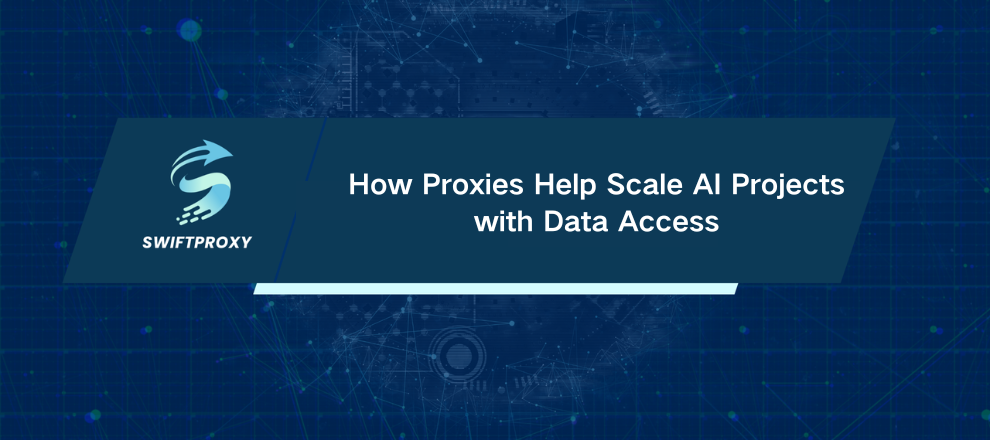How Proxies Help Scale AI Projects with Data Access

AI has transformed everything, including healthcare diagnostics, financial forecasting, and personalized e-commerce. However, as AI systems become more sophisticated, the challenge of scaling them increases dramatically because AI depends on one crucial factor—having massive and uninterrupted access to data. Without vast and diverse datasets, AI projects stall, and the bigger your AI ambitions, the harder it becomes to keep the data pipeline flowing smoothly.
However, the internet isn't an open highway. Geo-blocks, CAPTCHAs, and rate limits stand in your way. These barriers throttle your AI's ability to gather, learn, and adapt in real time. That's where proxies come into play—your secret weapon to break down walls and turbocharge AI scalability.
Why AI Projects Struggle to Scale and How Proxies Fix It
AI is data-hungry. It feeds on vast, varied datasets to train models, spot patterns, and make decisions. But most websites and platforms are designed to block automated data scrapers through IP bans, request limits, and geo-restrictions. Here are the core problems:
Geo-Restrictions: Need market data from Tokyo? Some sites lock you out unless you're local.
Rate Limits and CAPTCHAs: Bombarding a single IP with requests triggers blocks, slowing or stopping data collection.
Bias and Data Gaps: Limited access means incomplete datasets — which leads to flawed AI outcomes.
Meanwhile, AI projects also demand lightning-fast data processing, low latency, and rock-solid security to protect sensitive information. Without smart infrastructure, scaling hits a wall.
Proxies solve all of this. They act as middlemen, routing your AI's data requests through a pool of diverse IP addresses. This clever detour lets your AI slip past restrictions, speed up data retrieval, and keep its identity under wraps.
What Exactly Are Proxies and Why Should AI Teams Care
Imagine proxies as the Swiss Army knives of data collection. Instead of your AI system connecting directly to the web, it goes through these proxy servers. Each request can carry a different IP address—sometimes from New York, sometimes Berlin, or even a residential user in Brazil. This variation makes it almost impossible for sites to detect and block your AI's activities.
Different proxies serve different purposes:
Residential Proxies: Real IPs assigned by internet providers. They look like regular users, making them perfect for accessing geo-restricted and highly guarded content.
ISP Proxies: A hybrid that offers the speed of datacenter proxies but with real ISP-assigned IPs, balancing authenticity and performance.
How Proxies Drive AI Scalability
Unrestricted Data Access: Bypass IP bans and geo-blocks to tap into global datasets without interruption.
Distributed Traffic Management: Rotate IPs to avoid triggering rate limits or CAPTCHAs, keeping your scrapers humming smoothly.
Enhanced Speed and Efficiency: Load balancing across proxies reduces network congestion, lowering latency for real-time AI applications.
Stronger Security and Anonymity: Hide your AI's digital footprint, defend against DDoS attacks, and reduce vulnerability to adversarial interference.
Geo-Specific Data Collection: Target local datasets to train AI models tailored to regional nuances and languages.
Key Challenges When Scaling AI Projects
1. Data Collection Barriers
Geo-restrictions and IP bans restrict your access to critical datasets. With proxies, switch IPs dynamically to mimic real users worldwide and collect data unrestricted.
2. Speed and Bandwidth Limitations
High-volume AI models need fast, stable connections. ISP proxies and datacenter proxies reduce latency, ensuring your AI applications—like automated trading or fraud detection—run in real-time without hiccups.
3. Security Risks
Handling sensitive data online makes you a target. Proxies mask your AI infrastructure, preventing attackers from identifying and disrupting your systems.
Practical Use Cases
Natural Language Processing (NLP): Gather diverse language samples globally to train chatbots that truly understand cultural context.
E-commerce Price Monitoring: Rotate residential proxies to scrape competitor pricing across multiple countries without detection.
Cybersecurity AI: Use ISP proxies for fast threat detection while maintaining anonymity and avoiding counterattacks.
Fraud Detection Systems: Real-time data feeds through proxy networks reduce latency and keep the AI alert to suspicious activity instantly.
Choosing the Right Proxy for Your AI Project
Residential Proxies: Best for collecting rich, diverse datasets while avoiding bans. Ideal for AI models that need access to localized content or user-generated data.
ISP Proxies: Strike the perfect balance between speed and authenticity. Great for AI projects requiring high throughput and continuous monitoring, like cybersecurity or financial analysis.
Final Thoughts
Scaling AI isn't just about better algorithms or more compute power—it's about smart data access. Proxies unlock the data highways that fuel AI innovation. They tear down barriers, accelerate workflows, and protect your AI systems from digital threats.

















































